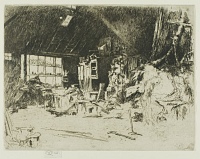The Smithy | ||
| Number: | 239 | |
| Date: | 1880 | |
| Medium: | etching and drypoint | |
| Size: | 177 x 229 mm | |
| Signed: | butterfly at lower right | |
| Inscribed: | no | |
| Set/Publication: | no | |
| No. of States: | 6 | |
| Known impressions: | 20 | |
| Catalogues: | K.240; M.237; W.197 | |
| Impressions taken from this plate (20) | ||
KEYWORD
anvil, blacksmith, forge, interior, man standing, worker.
TITLE
The only variations on the title are as follows:
'The Smithy' (1886, Frederick Wedmore (1844-1921)). 1 'Smithy' (1887/1888, Whistler). 2
'The Smithy' (1889, Whistler). 3
'The Smithy' is the generally accepted title.
'The Smithy' (1886, Frederick Wedmore (1844-1921)). 1 'Smithy' (1887/1888, Whistler). 2
'The Smithy' (1889, Whistler). 3
'The Smithy' is the generally accepted title.
1: Wedmore 1886 A[more] (cat. no. 197).
2: List, [1887/1888], GUW #13233.
3: List, 18 July 1889, GUW #13235.
DESCRIPTION
Whistler described it as: ' "Smithy" - very rich interior - smith filing at window - beautiful work in roof and background -' 4
4: Whistler to E. G. Kennedy, [12/15 February 1900], GUW #09799.
The interior of a blacksmith's shop, with a large window at the left, looking onto a house with a tiled roof. In front of the window a man stands bending over a work-bench. A shelf full of miscellaneous small objects and bottles runs across the window, supported on thin wooden struts. Further to left is a small window with four panes, and in the high-peaked roof, above the big window, is a skylight, partly veiled by a curtain, which casts a beam of light diagonally across the workshop. A medley of cupboards (just to right of the workbench), trestles, tools, sacks, pieces of iron, cloth and wood, fill the room. At the right two men are bending over an anvil, and behind them, at far right, is a man standing in front of the forge. The chimney and pipes and timber supports for the forge and buildings form a complicated network at upper right. In the foreground at left is a bucket and a small anvil, and, at right, two blacksmith's hammers.
SITE
Not known. The form of the tiles on the roof - which look like curved terra-cotta tiles - suggest that this might have been done in Venice. 5 Alternatively it could have been done in France on Whistler's return from Venice.
5: Los Angeles 1984 (cat. no. 51).
DISCUSSION
Forges, furnaces and smiths are a recurrent subject in Whistler's work, providing dramatic lighting and complex figure compositions. These include several etchings: The Forge 086, Nocturne: Furnace 208, Murano - Glass Furnace 205, Wheelwright 240 and Flaming Forge 490.
The subject is also seen in a lot of lithographs: The Tyresmith c036, The Whitesmiths, Impasse des Carmélites c092, The Forge, Passage du Dragon c102, The Smith, Passage du Dragon c103,
The Master Smith c120,
The Sunny Smithy c121,
The Good Shoe c122,
Father and Son c123,
The Strong Arm c125,
The Blacksmith c127 and The Brothers c128.
There are also a few drawings, Study for 'The Little Forge' (K.147) m0574,
Sketch of 'The Whitesmiths, Impasse des Carmélites' m1417,
Sketches of 'The Forge: Passage du Dragon' and 'The Smith: Passage du Dragon' m1450,
r.: The Blacksmith's, Howth; v.: Horse in a stable m1619,
r.: The Forge; v.: Smiths, Ajaccio m1679 and The Flaming Forge, Ajaccio m1678; and an oil,
The Little Forge, Lyme Regis y442.
